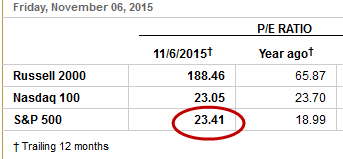This morning’s key headlines from GenerationalDynamics.com
- Price/earnings index surges as earnings and profits contract
- China’s import and export trade volumes plummet as deflation takes hold
Price/earnings index surges as earnings and profits contract

S&P 500 Price/Earnings ratio surges to 23.41 in last two weeks from 10/23 to 11/6, indicating a rapidly enlarging stock market bubble. (WSJ)
Companies listed in the S&P 500 index are looking at the third straight quarter of steep profit contraction. Third quarter profits fell about 15% from a year ago.
It is the third consecutive quarter in which earnings per share have fallen. In the second quarter, earnings contracted by 16%. In the first quarter, they fell 12.8%.
Sales numbers have also been consistently down, contracting down about 4%, falling in every quarter this year.
The result is that the S&P 500 price/earnings index has been surging. According to Friday’s Wall Street Journal, the S&P 500 Price/Earnings index (stock valuations index) on Friday morning (November 6) was at 23.41. The last time I posted it was just a couple of weeks ago, when it was 22.07 on October 23. In just two weeks, it went from an astronomically high 22.07 to a super-astronomically high 23.41, thanks to the plunging profits and earnings.
This is far above the historical average of 14, indicating that the stock market is in a huge bubble that could burst at any time. Generational Dynamics predicts that the P/E ratio will fall to the 5-6 range or lower, which is where it was as recently as 1982, resulting in a Dow Jones Industrial Average of 3000 or lower. WSJ blogs
China’s import and export trade volumes plummet as deflation takes hold

People’s Bank of China
Overseas shipments from China dropped 6.9% in October, a much bigger decline than expected. Even bigger was the 18.8% plunge in imports from other countries into China. The sharp decline in imports to and exports from the world’s second-biggest economy and “the economic engine of the world” is a sign of collapsing global trade, something that last happened in 2008 along with the financial crisis of that time.
At the same time, deflation is taking hold in China. The consumer price index (CPI) rose 1.3% in October, below the 1.5% that economists expected. But the biggest deflationary signal was the producer price index (PPI), representing prices paid by factories for commodities or components — that plunged 5.9%, its 44th straight monthly decline.
Many economists say that these figures will motivate China’s central bank, the People’s Bank of China (PBOC), to “print” a lot more money by means of massive quantitative easing (QE). Pouring money into the economy will supposedly end deflation, cause inflation, and stimulate growth. However, that has not worked when it was tried in the past. The main effect of China’s QE was to feed into China’s three huge bubbles: a credit bubble, a real estate bubble, and a stock market bubble. Some of these bubbles have already started bursting in recent months, and the PBOC will try to blow these bubbles up again.
Changes in China’s economy affect economies around the world, including the American economy. U.S. import prices fell 0.5% in October, after falling 0.6% in September, much farther than economists expected. China is said to be “exporting deflation” to the United States.
There are several reasons why U.S. import prices are falling. The deflationary trend in China, especially in the PPI, is one reason. Second, global oil prices and other energy prices have been falling sharply, and that affects almost everything.
The third reason is that with China and other nations devaluing their currencies through QE, the US dollar has been getting stronger and stronger, allowing an American using dollars to purchase more foreign goods than before, at lower prices as measured in dollars. Deflation trends are occurring in many countries, including America, and deflation tends to strengthen a currency domestically. But with other countries using QE, the dollar is also getting stronger internationally, compared to other currencies. Bloomberg and LiveMint (China) and Business Insider (9-Jul)
KEYS: Generational Dynamics, China, People’s Bank of China
Permanent web link to this article
Receive daily World View columns by e-mail

COMMENTS
Please let us know if you're having issues with commenting.